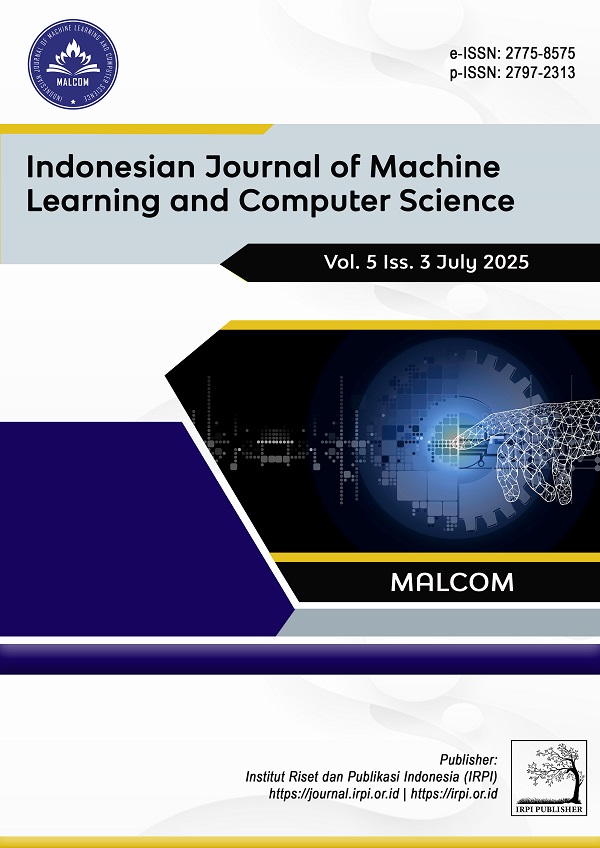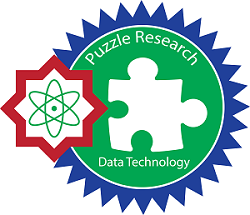Real-Time Road Damage Detection on Mobile Devices using TensorFlow Lite and Teachable Machine
DOI:
https://doi.org/10.57152/malcom.v5i3.1933Keywords:
Mobile Application, Real-Time Monitoring, Road Damage Detection, Teachable Machine , TensorFlow LiteAbstract
This study presents a mobile-based road damage detection system using Teachable Machine and TensorFlow Lite to support real-time monitoring and efficient infrastructure maintenance. The system identifies road damage types such as cracks, potholes, and uneven surfaces. The RDD2020 dataset is used for model training, with preprocessing steps including augmentation, normalization, and resizing. A Convolutional Neural Network (CNN) model is trained through Teachable Machine for ease of customization. TensorFlow Lite is employed for on-device inference, with optimization techniques like quantization and pruning applied to improve speed and reduce model size. The system is evaluated using precision, recall, F1-score, and accuracy metrics under varying lighting and weather conditions. The final model is deployed in a mobile app using TensorFlow Lite Interpreter for efficient performance. Experimental results show high detection accuracy, with a precision of X% and F1-score of Y% (insert actual values). This approach offers a lightweight, cost-effective solution for road maintenance authorities and urban planners. Future enhancements include dataset expansion, integration with mapping tools, and improved robustness in diverse environments. Overall, the proposed system enables real-time, accurate road damage detection and supports smarter, eco-friendly infrastructure management.
Downloads
References
S. Shim, J. Kim, S. W. Lee, and G. C. Cho, “Road damage detection using super-resolution and semi-supervised learning with generative adversarial network,” Autom. Constr., vol. 135, p. 104139, 2022, doi: 10.1016/j.autcon.2022.104139.
S. Zhang, X. He, B. Xue, T. Wu, K. Ren, and T. Zhao, “Segment-anything embedding for pixel-level road damage extraction using high-resolution satellite images,” Int. J. Appl. Earth Obs. Geoinf., vol. 131, no. June, p. 103985, 2024, doi: 10.1016/j.jag.2024.103985.
S. Swain and A. K. Tripathy, “Automatic detection of potholes using VGG-16 pre-trained network and Convolutional Neural Network,” Heliyon, vol. 10, no. 10, p. e30957, 2024, doi: 10.1016/j.heliyon.2024.e30957.
K. A. Vinodhini and K. R. A. Sidhaarth, “Pothole detection in bituminous road using CNN with transfer learning,” Meas. Sensors, vol. 31, no. November 2023, p. 100940, 2024, doi: 10.1016/j.measen.2023.100940.
K. Struniawski and R. Kozera, “TfELM: Extreme Learning Machines framework with Python and TensorFlow,” SoftwareX, vol. 27, no. April, p. 101833, 2024, doi: 10.1016/j.softx.2024.101833.
A. Ndaka, P. J. C. Lassou, K. A. S. Kan, and S. Fosso-Wamba, “Toward response-able AI: A decolonial perspective to AI-enabled accounting systems in Africa,” Crit. Perspect. Account., vol. 99, no. April, p. 102736, 2024, doi: 10.1016/j.cpa.2024.102736.
K. E. Pilario, “Teaching classical machine learning as a graduate-level course in chemical engineering: An algorithmic approach,” Digit. Chem. Eng., vol. 11, no. May, p. 100163, 2024, doi: 10.1016/j.dche.2024.100163.
D. Akgun, “TensorFlow based deep learning layer for Local Derivative Patterns,” Softw. Impacts, vol. 14, no. December, p. 100452, 2022, doi: 10.1016/j.simpa.2022.100452.
D. Al-Fraihat, Y. Sharrab, A. R. Al-Ghuwairi, H. Alzabut, M. Beshara, and A. Algarni, “Utilizing machine learning algorithms for task allocation in distributed agile software development,” Heliyon, vol. 10, no. 21, p. e39926, 2024, doi: 10.1016/j.heliyon.2024.e39926.
M. Mazzei and A. M. Di Lellis, “Capacitive accelerometers at low frequency for infrastructure monitoring,” Procedia Struct. Integr., vol. 44, no. 2022, pp. 1212–1219, 2022, doi: 10.1016/j.prostr.2023.01.156.
P. S. Janardhanan, “Project repositories for machine learning with TensorFlow,” Procedia Comput. Sci., vol. 171, no. 2019, pp. 188–196, 2020, doi: 10.1016/j.procs.2020.04.020.
H. Greenspan, R. San José Estépar, W. J. Niessen, E. Siegel, and M. Nielsen, “Position paper on COVID-19 imaging and AI: From the clinical needs and technological challenges to initial AI solutions at the lab and national level towards a new era for AI in healthcare,” Med. Image Anal., vol. 66, no. April, p. 101800, 2020, doi: 10.1016/j.media.2020.101800.
D. Arya, H. Maeda, S. K. Ghosh, D. Toshniwal, and Y. Sekimoto, “RDD2020: An annotated image dataset for automatic road damage detection using deep learning,” Data Br., vol. 36, p. 107133, 2021, doi: 10.1016/j.dib.2021.107133.
B. Ekanayake, J. K. W. Wong, A. A. F. Fini, P. Smith, and V. Thengane, “Deep learning-based computer vision in project management: Automating indoor construction progress monitoring,” Proj. Leadersh. Soc., vol. 5, no. December 2023, p. 100149, 2024, doi: 10.1016/j.plas.2024.100149.
T. Setiyono et al., “Application of TensorFlow model for identification of herbaceous mimosa (Mimosa strigillosa) from digital images,” Smart Agric. Technol., vol. 7, no. December 2023, p. 100400, 2024, doi: 10.1016/j.atech.2024.100400.
C. L. Gabriel et al., “Ten meter walk test with mobile devices: A dataset with accelerometer, magnetometer, and gyroscope,” Data Br., vol. 52, p. 109867, 2024, doi: 10.1016/j.dib.2023.109867.
M. Carney et al., “Teachable machine: Approachable web-based tool for exploring machine learning classification,” Conf. Hum. Factors Comput. Syst. - Proc., 2020, doi: 10.1145/3334480.3382839.
M. N. A. Ramadan, M. A. H. Ali, S. Y. Khoo, and M. Alkhedher, “AI-powered IoT and UAV systems for real-time detection and prevention of illegal logging,” Results Eng., vol. 24, no. October, p. 103277, 2024, doi: 10.1016/j.rineng.2024.103277.
A. Hosseini et al., “A mobile application based on efficient lightweight CNN model for classification of B-ALL cancer from non-cancerous cells: A design and implementation study,” Informatics Med. Unlocked, vol. 39, no. April, p. 101244, 2023, doi: 10.1016/j.imu.2023.101244.
N. C. A. Sallang, M. T. Islam, M. S. Islam, and H. Arshad, “A CNN-Based Smart Waste Management System Using TensorFlow Lite and LoRa-GPS Shield in Internet of Things Environment,” IEEE Access, vol. 9, pp. 153560–153574, 2021, doi: 10.1109/ACCESS.2021.3128314.
W. K. Anuar, L. S. Lee, and S. Pickl, “Benchmark dataset for multi depot vehicle routing problem with road capacity and damage road consideration for humanitarian operation in critical supply delivery,” Data Br., vol. 41, p. 107901, 2022, doi: 10.1016/j.dib.2022.107901.
M. Katsigiannis and K. Mykoniatis, “Enhancing industrial IoT with edge computing and computer vision: An analog gauge visual digitization approach,” Manuf. Lett., vol. 41, pp. 1264–1273, 2024, doi: 10.1016/j.mfglet.2024.09.153.
S. Moya and M. Camacho, “Leveraging AI-powered mobile learning: A pedagogically informed framework,” Comput. Educ. Artif. Intell., vol. 7, no. February, p. 100276, 2024, doi: 10.1016/j.caeai.2024.100276.
K. Holden and M. Harsh, “On pipelines, readiness and annotative labour: Political geographies of AI and data infrastructures in Africa,” Polit. Geogr., vol. 113, no. December 2023, p. 103150, 2024, doi: 10.1016/j.polgeo.2024.103150.
M. Ntemi, S. Paraschos, A. Karakostas, I. Gialampoukidis, S. Vrochidis, and I. Kompatsiaris, “Infrastructure monitoring and quality diagnosis in CNC machining: A review,” CIRP J. Manuf. Sci. Technol., vol. 38, pp. 631–649, 2022, doi: 10.1016/j.cirpj.2022.06.001.
E. Papadimitriou, A. Pooyan Afghari, D. Tselentis, and P. van Gelder, “Road-safety-II: Opportunities and barriers for an enhanced road safety vision,” Accid. Anal. Prev., vol. 174, no. June, p. 106723, 2022, doi: 10.1016/j.aap.2022.106723.
Downloads
Published
How to Cite
Issue
Section
License
Copyright (c) 2025 Lusindah Nova, Yan Rianto

This work is licensed under a Creative Commons Attribution-ShareAlike 4.0 International License.
Copyright © by Author; Published by Institut Riset dan Publikasi Indonesia (IRPI)
This Indonesian Journal of Machine Learning and Computer Science is licensed under a Creative Commons Attribution-ShareAlike 4.0 International License.




















